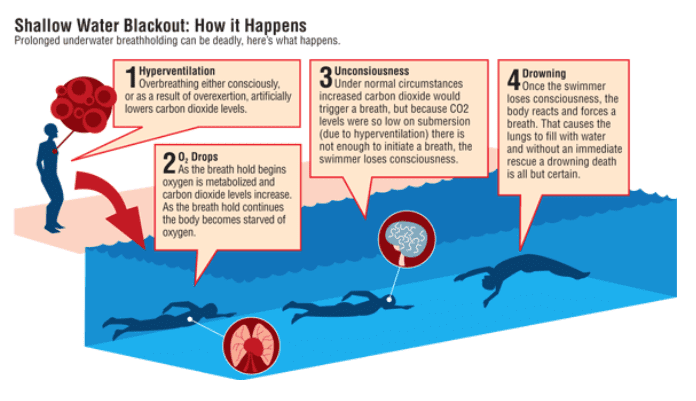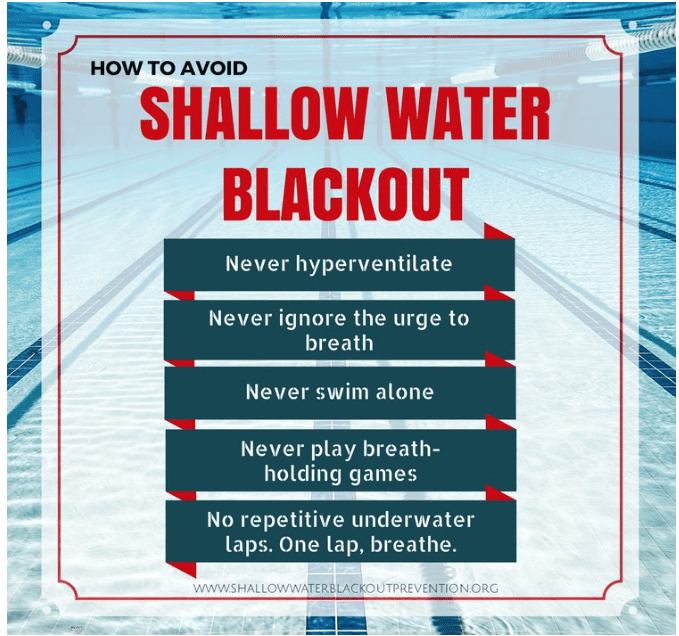In the U.S. alone, there about 4,000 drowning deaths each year. While the death rate has decreased over the last four decades, it’s reported that the rate of fatalities due to shallow water blackout has not.
Shallowwaterblackoutprevention.org defines it as: Shallow water blackout is an underwater “faint” due to a lack of oxygen to the brain brought on by holding your breath for long periods of time. Without immediate rescue, the swimmer quickly drowns; or more formally:
-
- Shallow Water Blackout results from hypoxia — low oxygen — to the brain. What triggers one to breathe in elevation of carbon dioxide, not low oxygen. One basically ‘blacks out’ or faints in the water. For some, their lungs will take on water leading to drowning. Others simply suffocate or die of other causes brought on by the breath-holding.
- Death can be a result of the prolonged breath-holding, even if not from so called ‘Shallow Water Blackout.’ Breath-holding may stimulate genetic triggers leading to various causes of death.
Other terms for shallow water blackout include: hypoxic blackout, underwater blackout, underwater blackout syndrome, sudden underwater blackout syndrome (SUBS), breath-holding blackout and free-diver blackout.
It can occur in an olympic pool or the bath tub. It’s caused by breath-holding, regardless of where it occurs.
Who is at Risk?
So, it happens to amateur swimmers and pool-goers, right?
It’s actually most common among physically fit swimmers, spear fishermen and free drivers. While it has been a worrisome trend in Australia for a while — due to the coast and snorkeling adventures — it may be a worry you’ve never heard about. Many know it as a silent killer. In fact, it occurs in only two minutes, opposed to regular drowning which takes six to eight minutes.
In fact, Swimming Canada Nation reports “coaches in aquatic sports have used hypoxic training techniques for years. Commonly know as lung busters, over/under, under water kick drills and Tennessee Turns many drills have used hypoxic training to try to improve a swimmers breath holding ability and perhaps the anaerobic threshold.”
The Story of Gene “Whitner” Milner
25-year-old Gene “Whitner” Milner was interested in spear fishing and began to practice his breath-holding. But on April 17, 2011, Whitner died from shallow water blackout in his family’s swimming pool.
The website, shallowwaterblackoutprevention.org went live in June 2011 following his death. It hopes to shed light on shallow water blackout and help prevent these deaths that the website refers to as “completely preventable.”
Here the story from the website:
“The day Whitner died he was full of joy and happiness. He had spent the day at the Atlanta Steeplechase with his friends and little sister, Scottie. Following the Steeplechase, a group of his friends and his sister’s friends came back to his parent’s house to cool off and enjoy the pool and hot tub. The group were swimming laps, racing each other and competing to see who could hold their breath the longest.
“The last anyone remembers seeing Whitner is when friends were getting out of the pool around 10:30 to 11 p.m. that evening. The pool lights were not on and his friends were coming and going. Whitner likely tried to hold his breath one last time, unnoticed by those around the pool. He experienced shallow water blackout and passed out in the water without any forewarning sinking directly to the bottom of the pool. His friends thought that he had gone inside to call his girlfriend, Laura Dobrosky, who was out of town.
“Several people were by the pool during the day collecting towels and personal items. No one ever saw him at the bottom of the pool, showing how difficult it can be to detect a drowning. He was not found until the following Sunday evening around 7:45 p.m. by his mother because she went out to turn off lights by the pool.”
Shallow Water Blackout Prevention
Share the information you learned with others, both in your facility and outside of. Inform your lifeguards to try and monitor those who are training for swim meets by making sure they come up for a proper breath. Never allow breath-holding games. Inform pool goers to breathe when they have the urge.













Thank you for sharing Whitner story and raising awareness of the dangers of breath holding.
When I was just 13 years old , I almost blacked out in a pool while I was diving to the bottom . My oxygen started running out near the surface and things started to get blurry. If I hadn’t made it in time , I probably would have drowned .
I was recently watching a youtube video of a marriage proposal that turned tragic. This guy swam 30 feet under water, to this underwater “chamber” where his girlfriend was in. She saw him in the water, on the other side of the glass wall separating them. He held up a sign of him professing his undying love for her, and asked her to marry him. You could see him shaking as he was about to run out of air. He took off, swimming upwards, but sadly, he never made it out of the water. He passed away from either drowning, or perhaps a deeper version of ‘shallow water blackout’, if one exists. It was very sad, as the happiest day of his girlfriend’s life turned into the saddest day within minutes. Jusy thought i would share this story.
Karima, thank you so much for your wonderful article raising awareness on the dangers of underwater death-holding. Thank you for sharing Whitner’s story, but there are so many amazing people who have died tragic deaths from prolonged breath-holding as witnessed in our many memorials. Our survivor stories give evidence that blackout occurs without warning.
Two major events have occurred that will lead to increased awareness and signage. In Staten Island, NY the recreation and parks have been found responsible in a death that occurred from SWB, actually there were two simultaneous blackouts leading to death. This means that these facilities going forward need to not allow this activity and warn of the dangers of underwater breath-holding. Also, there is a current case brought against a coach in a SWB of one of his swimmers. This case will certainly draw attention to the common practice of no-breathers by swim teams and the risks that swimmers are being subjected to from prolonged breath-holding. These deaths occur much more frequently than previously thought and should be suspected when a healthy swimmer is found dead in a body of water.
We would like to share your well written article on our website and social media.
Thank you,
Rhonda
Rhonda Milner, MD
Founder and Chairman, Shallow Water Blackout Prevention
http://www.shallowwaterblackoutprevention.org
Do you have an estimate of the number of people who die from SWB each year.
In Australia :
https://www.mja.com.au/journal/2018/208/6/drowning-deaths-australia-caused-hypoxic-blackout-2002-2015
Today Olympic snowboarder Alex (Chumpy) Pullin 32yo lost his life due to this off Palm Beach On Go,d Coast Qld. May he RIP and condolences to his family. I had never heard of this condition before.
How common is shallow water blackout in just average swimmers? Do you have numbers? I used to swim years ago and now I’m very out of shape and want to start swimming again. I get winded , like most, after a couple slaps. My question is exactly how rare is this? And can this happen just with recreational swimming like freestyle breathing every 3 strokes or so?
I have a question. Free-diver training involves CO2 tolerance. Is it possible for someone that has trained to have a very high CO2 tolerance but with a normal O2 tolerance to blackout more easily? Since the urge to breathe comes from CO2 buildup and the unconsciousness results from lack of oxygen, my thinking is that a diver with a high CO2 tolerance may blackout before feeling that extreme urgent panic need to breathe.